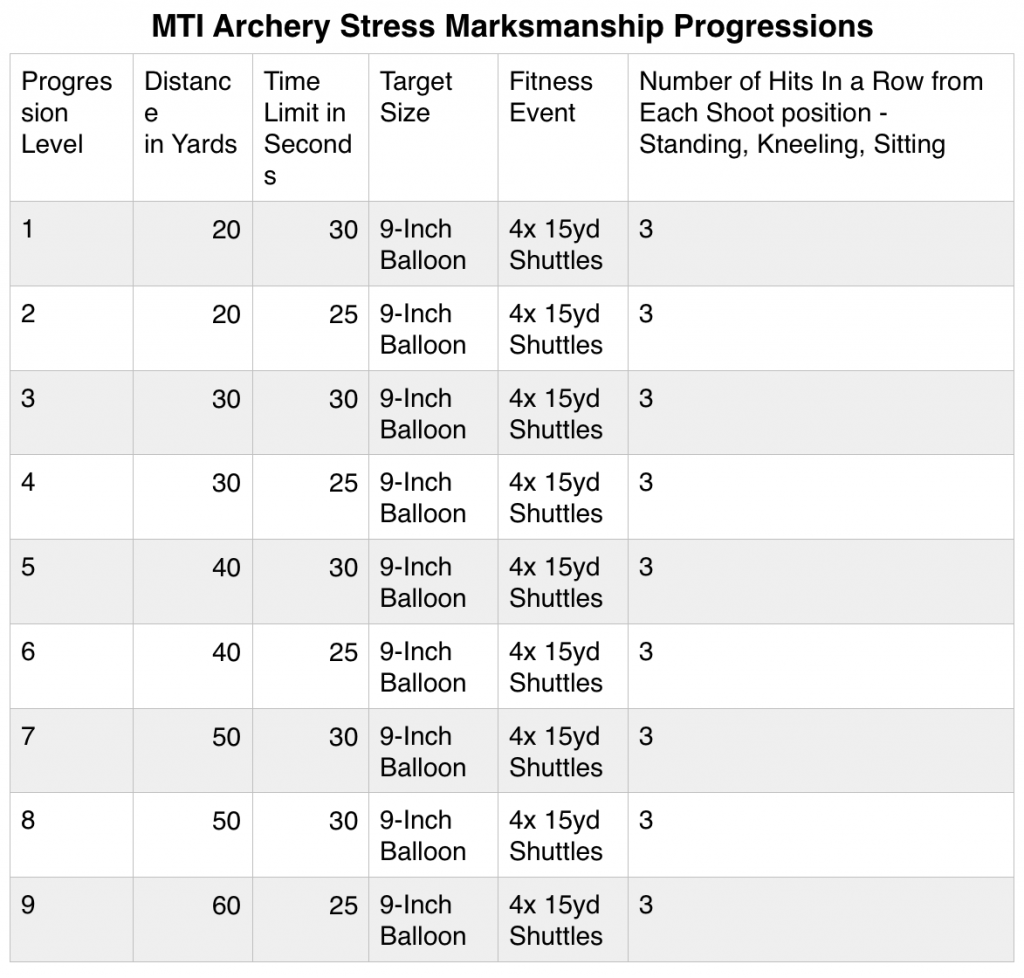
By Rob Shaul
At the beginning of last year’s bow hunting season, I was nailing tacks at my home archery range. My 20-yard groups were under 2”. My 40 yard groups were right at 4”. Out to 70 yards, I was hitting inside a 12” circle 7 of 10 shots.
Then, during the actual hunting season, I missed an easy 60 yard shot on a monster mule deer. An easy 50 yard shot on a young buck antelope, and a really easy, 40-yard shot on another monster deer.
No pressure, on my flat range in the yard, I was cool, calm and lethal. My fundamentals were solid.
Out in the field, with an animal standing there looking at me, I was an emotional wreck … hearth thumping, hands shaking, release finger twitching. My fundamentals sucked.
I made many mistakes hunting last year, but not systematically training accurate archery marksmanship under stress is especially embarrassing.
Those of you who have followed our work over the years know of our Range Fitness program – which systematically trains accurate marksmanship under stress suing assault rifles and side arms.
Turns out that all the matters in bow hunting is accurate marksmanship under stress. And to improve this skill, bow hunters need to practice it.
Looking back now, a couple major distractions blinded me to what was important last year.
First, I spent a lot of time and money trying to develop a reactive archery target. Our stress marksmanship systems require reactive targets – where the shooter immediately gets hit or miss feedback.
We use metal targets for our firearm Range Fitness system. Last summer I hired an engineer and together we spent several weeks trying to develop a fancy similar reactive target for archery. It was a huge distraction. Turns out Balloons are a simple, cheap and super effective reactive archery target. Stupid distraction number 1.
Second, I got sucked into the bow hunting circle jerk of bows and sites and releases and arrows and bow tuning and bunches of “experts” with advice all trying to sell me something. They made a lot of money off me last year – 2 bows, multiple sites, 3 releases, dozens of arrows, hours at the bow shop tuning and tweaking. Turns out the fanciest bow, best reviewed release, highest-end bow sight, and carbon arrows won’t stop your heart from pounding, hands from shaking, and complete ignorance of archery fundamentals when you’ve worked 4 hours stalking a buck antelope and finally line up for the shot.
Stupid distraction number 2.
Here is a concise list of my archery marksmanship mistakes from last year
- – Thinking a gear “upgrade” would make me a better shooter. Gear is never the reason.
- – Placing way too much value on target shooting improvement. Never will the target I shoot at (big game vitals) be smaller than 9-inches in diameter. “Experts” argue that shooting at small targets on the flat range will give you a greater margin of error during the real thing out in the field. This certainly didn’t work for me, and hasn’t for many others. Bad advice.
- – Not systematically training accurate archery marksmanship under stress – like I’ve done so many times using firearms. This is a big one.
Moving forward
Myself and any lab rat I can find with a bow are now developing the MTI system. “System” is important … we want to apply the rules of “purposeful practice” quantified by researcher Anders Ericsson and already deployed in our firearms Range Fitness system. (I strongly recommend Ericsson’s book, “Peak”)
In general, the goal is to develop a system to constantly push the shooter to his/her edge of performance. We’re not starting from zero … We’re deploying many of the lessons learned from our Range Fitness system. Here are the stressors:
- – Fitness hit (simple shuttle sprints) – it’s amazing what just 4x 15 yard shuttle sprints can do to your breathing and heart rate
- – Time limit (still tweaking here, but first level is 30 seconds. Second likely 25 seconds)
- – Ammo Limit – you only get one shot at the target – just like during hunting season
- – Competition – in the video you’ll Wyatt and myself conduct this event individually. Later we conducted it side by side … and it increased the stress. (I beat him – so awesome!)
Progression?
Right now I’m thinking the first “standard” will be 3 hits at a certain distance and 30 second time limit, from 3 shooting positions – standing, kneeling, sitting, starting at 20 yards. In the video you’ll see us shoot at 30 yards, 30 seconds.
Below is my initial thoughts on progression moving forward. Note that the archer cannot move to the next progression level until he/she has hit 3 balloons in a row, with a 25 second time limit from all three shooting positions – standing/kneeling/sitting.

What about practicing fundamentals?
With Range Fitness we learned fast that we could only improve so much doing these stress events over and over. We had to back up, and take time to purposefully practice shooting fundamentals and in the end, every Range Fitness training session began with a stress shoot, then spent time practicing one or two fundamentals, then finished with another stress shoot.
However, we did learn that not all shooting fundamentals are equal in they’re impact on our stress shoot performance. Specifically, trigger control was by far the most difficult to master, but also had the greatest positive impact on stress shoot performance. Next came follow through, then breathing, and finally weapon handling (shooting position stuff.)
Already I’m betting trigger control for mechanical releases will be the most important fundamental impacting our archery stress marksmanship. I’ll learn more over the next few months.
Comments/Questions?
Email coach@mtntactical.com